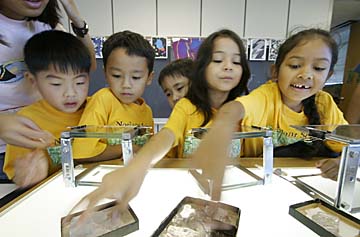
DENNIS ODA / DODA@STARBULLETIN.COM
Noelani Elementary students Raynor Moux, 7, Sheldon Saito, 7, Colin Saito, 6, Tina Matias, 7, and Prita Narayan, 7, studied the optical properties of different thinly sliced minerals at yesterday's UH School of Ocean and Earth Science and Technology open house.
|
|
Cool science
Thousands of schoolchildren learn what makes the earth move at a UH science expo
Lanakila Elementary fourth-grader Jerahmeel Usita-Ponce was thrilled when he hit the ground with a hammer and made an earthquake.
"That's a beauty," said Fred Duennebier, geology and geophysics professor, who was running a "Make a Quake" demonstration, explaining the seismogram to the youth.
"This is really good," Jerahmeel said.
He was among some 3,000 Oahu students who went to an open house at the University of Hawaii School of Ocean and Earth Science and Technology yesterday.
Some of them could be tomorrow's scientists.
But even those with no bent for science were fascinated with the many hands-on demonstrations, presentations, laboratory tours, computer animation, high-tech displays and learning activities put on by the school's scientists, researchers, staff and students.
Students from private, public and home schools were hosted by SOEST yesterday. The events were open to the public today in and around the Pacific Ocean Science & Technology Building, Marine Science Building and Hawaii Institute of Geophysics.

DENNIS ODA / DODA@STARBULLETIN.COM
Jered Edwards, 13, of King Intermediate School looked through a magnifying lens.
|
|
Classes moved through more than 70 wide-ranging demonstrations, videos and creative learning activities, such as a laser light show, wave machine aerosols in the atmosphere and underwater vehicles powered by fuel cells.
Among others were "A Field Trip to Mars," meteorites and asteroids, fault formation and dike eruptions in Hawaii, ground-water contamination, volcanoes, sea floor mapping, climate puzzles and useful bugs from the ocean.
Students saw images from the Hawaii Undersea Research Laboratory's recent submersible explorations of volcanoes in American Samoa and New Zealand.
In a presentation on the December Sumatra earthquake and tsunami, students learned the earthquake released as much energy in 400 seconds as all of the United States uses in six months.
First-grader Isabella-Marie Geppert of St. Andrew's Priory had a hard time focusing but finally was able to see through a microscope at micro-fossils, tiny seashells that float in the open ocean. "I saw a lot," she said.
Students were engrossed as Rebecca Scheinberg described the food chain in the ocean, asking, "What is plankton?"
"Microscopic sea bugs," a child piped up.
"A perfect answer," said Scheinberg, explaining that phytoplankton "look really weird" -- different from plants on land because of waves and currents and other conditions in the ocean.
"I love science," said Joshua Pokraka, Wilson Elementary fourth-grader. "You get to explore. You get to discover things."
He said he discovered a silver rock once while camping with his dad in the woods somewhere.
Also proclaiming their love for science were eighth-graders Amy Higham and Mikel Zichittell and sixth-grader Jesse Nielsen, all of the Academy of the Pacific.
"I always get A-pluses," Zichittell said. Hanael Chang and eighth-grade classmates from King Intermediate wore bands on their faces reading "E=mc2," which they excitedly explained meant Einstein's theory of relativity.
Students were enthralled as researchers mixed shaving cream with a little water and food coloring, put it in bottles and added dry-ice cubes to create eruptions.
The mixtures bubbled up and over and shot geysers into the air, to appreciative squeals and "ohs" from the crowd.
Aaron Chan, Maryknoll fourth-grader, and his friends watched geology and geophysics professor Garrett Ito simulate a caldera, a giant volcanic sinkhole, with flour, sand and a water balloon.
"See the rings and cracks. It's all concentric, the same shape," Ito said. "And there's a landslide right there. You can pretend you're a little person there on the cliff."
"I understand how volcanoes work now," Chan said.

